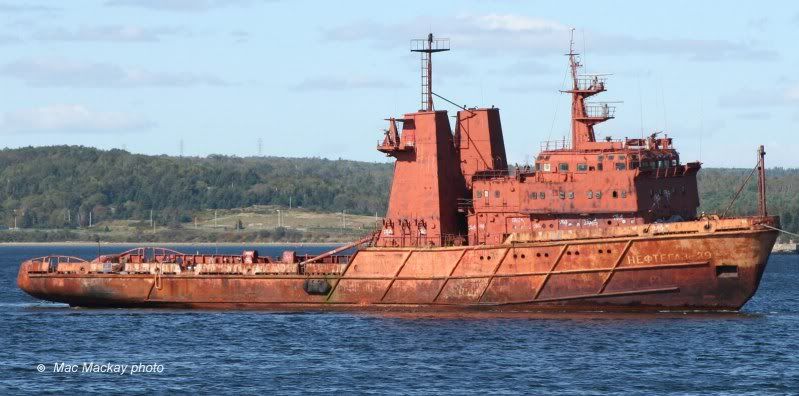[QUOTE=Sweat-n-Grease;93715]You think there will be rumble in the jungle. I have my doubts.[/QUOTE]
Hi S-n-G, probably not but having worked in both industries, the good megayacht builders clearly believe in , well you weld it once why not weld it in the right place.
They also believe in repeat customers and give warranty hence things are designed to reduce maintenance costs, just about the opposite of a commercial vessel
I see tons of detail done poorly on commercial vessels that could be way better at nil cost.
Trouble is many are bad design forced by class.
( class who earn their money by classing new vessels so they are not interested in them lasting are they and the ship yards are in full agreement)
[QUOTE=“powerabout;93713”]
Any decent mega yacht has been doing this for 25+years…
( the same yards that say we wont build down to class sir please go to another yard)[/QUOTE]
Chouest does that now, but I don’t know if it was done on the Aiviq.
I refuse to believe that water entering ONE vent could cause all the engines to fail. IF the vessel has a common vent setup, with overfill tank like most new builds do, it would take hundreds, if not a thousand gallons of sea water to fill up the vent tank, AND THEN the water would have to make its way through the vent piping into the fuel tanks. This scenario seems highly unlikely unless the vent was continuously submerged AND the alarm on the overflow/vent tank was not functioning. IF the day tanks (I would assume multiple day tanks for a vessel like this) had their own dedicated vents, sea water ingress in one vent would still not kill all the engines. It just doesn’t add up. Does anyone know if the auxiliaries were lost with the mains, or only the mains?
If there are any shipyard workers out there who worked on this vessel, following this thread, and would like to leak some information about the fuel tank/vent arrangement, please do!
[QUOTE=captfish;93751]
If there are any shipyard workers out there who worked on this vessel, following this thread, and would like to leak some information about the fuel tank/vent arrangement, please do![/QUOTE]
Doubt that will happen. None of the ship yard workers that actually do the work in Gary’s yards speak english. All the welders and fitters speak polish and the rest speak spanish.
And even if seawater did make it down the vents, what happened to the centrifuges, raycors, etc?
[QUOTE=dirwood;93718]If it turns out that water was NOT the cause of the injector failures I would be interested if carboxylate soaps may have been a factor. I have seen a recent case of contaminated fuel that caused a build up of these carboxylate soaps to form a sticky residue inside the injectors that when load was taken off the engines and cylinder temps dropped caused the injector to fail as the carboxylates residue gets much more viscous. This particular instance required the replacement of 72 CAT electronic unit injectors and the assistance of a forensic lab to determine what took place. Cummins has a great report out on this topic and can be found via google search.[/QUOTE]
This fits the known facts well. It’s also easy to understand why someone on the crew might believe they took water in a vent.
I’ve never head of these caboxylate soaps before but their unfamiliarity may just mean its an emerging problem many mariners have never encountered before
K.C.
[QUOTE=powerabout;93739]Hi S-n-G, probably not but having worked in both industries, the good megayacht builders clearly believe in , well you weld it once why not weld it in the right place.
They also believe in repeat customers and give warranty hence things are designed to reduce maintenance costs, just about the opposite of a commercial vessel
I see tons of detail done poorly on commercial vessels that could be way better at nil cost.
Trouble is many are bad design forced by class.
( class who earn their money by classing new vessels so they are not interested in them lasting are they and the ship yards are in full agreement)[/QUOTE]
“too many cooks spoil the broth”
[QUOTE=dirwood;93718]If it turns out that water was NOT the cause of the injector failures I would be interested if carboxylate soaps may have been a factor. I have seen a recent case of contaminated fuel that caused a build up of these carboxylate soaps to form a sticky residue inside the injectors that when load was taken off the engines and cylinder temps dropped caused the injector to fail as the carboxylates residue gets much more viscous. This particular instance required the replacement of 72 CAT electronic unit injectors and the assistance of a forensic lab to determine what took place. Cummins has a great report out on this topic and can be found via google search.[/QUOTE]
Could very well be both the soap and water:
“these detergents are specifically designed to be soluble in oil, and insoluble in water”
https://www.oronite.com/pdfs/CarboxylatesProductSummary.pdf.
Could very well be we are all grasping at straw and the real Boggy Bear is something else, yet, we are offering cogent arguments.
We had a boat working out of Dutch Harbor a few years ago and had fits with the fuel supply we were subject to (from what i recall). To make matters worse it was an older boat and the rough weather shook up any algae, crud, etc… that were in the fuel tanks so we went thru filters like crazy. We never had the boat shut down on us but the quality of fuel was terrible.
Not sure if this was a contributing problem but makes you wonder.
This thing is being scrapped in Boston after years idle in Halifax…too bad, a pair of them could have been good for the job! Has an icebreaking bow below waterline. Big rudders/nozzles, stern roller etc.

[QUOTE=z-drive;93942]This thing is being scrapped in Boston after years idle in Halifax…too bad, a pair of them could have been good for the job! Has an icebreaking bow below waterline. Big rudders/nozzles, stern roller etc.[/QUOTE]
Now that’s what I’m talking about!

Wouldya just look at the BRAWN!
The fuel in Dutch Harbor comes straight from the refinery in Valdez, every boat in he Bering Sea is using the same fuel…
Im looking forward to seeing this whole thing on the weather channel show ‘Coast Guard Alaska’
I’m one of the reporters covering the Kulluk situation for the Anchorage Daily News. I’m interested in hearing from anyone with first-hand knowledge of the original decision to depart Dutch Harbor on Dec. 21, the original tow plan, contingency plan and then the loss of control of the Kulluk and subsequent grounding. I’d also like to hear from a mariner who knows the route, the weather and can speak about the decision to cross the Gulf of Alaska when they did, even if you’re not involved directly. I can be reached at 907-257-4390 or ldemer@adn.com. Among the things I’m looking into is the fact that even if the weather forecast was good on Dec. 20-21, the slow speed of the Aiviq while towing the Kulluk meant that at the time they left, they wouldn’t know what they were heading into across the Gulf of Alaska. How does it make sense to go anyway? That’s one thing. Then there’s the repeated “separation” of towlines involving various vessels. Any idea why that kept happening? Anyone able to speak to the original tow plan and whether there were weather ceilings – ie no go or get into safe harbor if 20 foot seas, that sort of thing? Also, anyone able to address whether they were in fact trying to get to safe harbor at the end on New Year’s Eve, when the Aiviq’s final towline broke and the Alert was directed to let go? Any info on the Aiviq’s engines and the failures there? Interested also in the tow package and better description of the type of towline, the winch, shackle etc. I’m not a professional mariner and need everything in lay terms, not too technical. Hope it’s OK for a reporter to be posting here. This has been such a massive deal and it’s not over yet. I’m going to put this same post on the other thread, on the Kulluk. Thanks in advance – Lisa
I have heard many of stories of injector seizures on the 3600/C280 engines, especially during large load changes… maybe like those that would be seen after breaking a tow?
https://docs.google.com/open?id=1kSZHC1JcIMnZqCV6r9r_TsMv0bQqAHyGhf8t967G35-SAKr0jdg9eomaA_dl
[QUOTE=CurryAK;93981]Im looking forward to seeing this whole thing on the weather channel show ‘Coast Guard Alaska’[/QUOTE]
I’m waiting to see Shell say that the senior engineer on this whole project had 3 years experience since leaving college…
( and the degree was in something that ended in ology)
( Didnt the ex boss of BP have an ology??)
edit yes…from wikipedia
[I]Tony Hayward was born in Slough, Buckinghamshire, in 1957; the eldest of seven children. Later on, his family moved to nearby Windsor.[SUP][2][/SUP] After attending the local state grammar school, he went on to gain a first class geology degree from Aston University[SUP][3][/SUP][/I]
[QUOTE=“z-drive;93942”]This thing is being scrapped in Boston after years idle in Halifax…too bad, a pair of them could have been good for the job! Has an icebreaking bow below waterline. Big rudders/nozzles, stern roller etc.
[/QUOTE]
There is another one of these in Boston just past the Chelsea pier through the Mccartel Bridge.
Getting warmer…
[QUOTE=captfish;93751]I refuse to believe that water entering ONE vent could cause all the engines to fail. IF the vessel has a common vent setup, with overfill tank like most new builds do, it would take hundreds, if not a thousand gallons of sea water to fill up the vent tank, AND THEN the water would have to make its way through the vent piping into the fuel tanks. This scenario seems highly unlikely unless the vent was continuously submerged AND the alarm on the overflow/vent tank was not functioning. IF the day tanks (I would assume multiple day tanks for a vessel like this) had their own dedicated vents, sea water ingress in one vent would still not kill all the engines. It just doesn’t add up. Does anyone know if the auxiliaries were lost with the mains, or only the mains?
If there are any shipyard workers out there who worked on this vessel, following this thread, and would like to leak some information about the fuel tank/vent arrangement, please do![/QUOTE]
To meet class for a DP2 vessel with 4 main engines, they would have to have 2 engines on each side, with a settling tank and day tank for each side, completly independant of each other including the vents. However it is very common to have cross over lines between the day tanks and settlling tanks. To be DP2 class these cross over lines have to have a block valve and be closed while on DP. They were not on DP when this failure occured they were towing. It is possible they had the cross overs open and pulling fuel from one tank to fill both settling and or day tanks. If the tank they were using fuel from was severly comtaminated, I guess this is possible. It is not real smart to run this way, and I would strongly advise against it, but I was not there, and have no idea how they were operating the boat. Just saying that it could be possible, if everything was done a certain way. I would hope that the crew was not operating like this.
If they lost all 4 main engines, and it was because of water, I can’t think of any other way this could have happened though on a DP2 class vessel. Unless the fuel was contamintaed with soap or something similar as posted earlier.